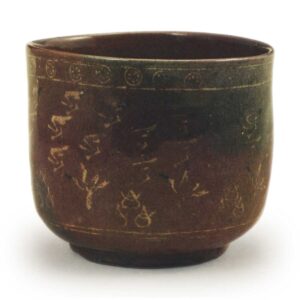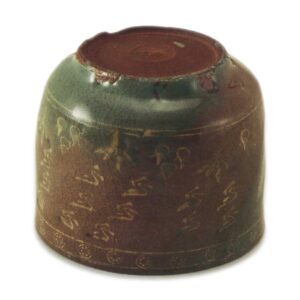

Height: 9.8 – 10.0 cm
Diameter: 10.2 – 12.0 cm
Outer diameter of foot ring: 7.3 – 7.5 cm
Height of foot ring: 0.8 cm
There are two types of tea bowls called Unkaku and Kyogen Hakama: those made at the end of the Goryeo period, and those made around the time of the Japanese invasions of Korea (1592-1597). If we look at the items recorded in the Taisho Meiki Kan, the Fujibakama (daimyo item) of the Owari Tokugawa family, the Kyogen Hakama (daimyo item) of the Hirado Matsuura family, the Kyogen Hakama Te of the Umakoshi family, the Hikigisaya (daimyo item) of the Osaka Yamada family, and the Wakasu such as the Hikita-zutsu (daimyo-mono) of the Sakai family of Wakasa, are tea bowls from the end of the Goryeo period, while the Jorogana of the Masuda family, the Shinonome of the Fujita family, and the Unkakuzutsu of the Murayama family are thought to have been made around the time of the Imjin War. This Unkakutsutsumi tea bowl belongs to the latter category, and it is thought to have been made in a kiln near Busan at the request of a Japanese customer around the time of the Bunroku-Keicho War.
The body is a semi-porcelain material with a high iron content, and it is tightly fired to a reddish-black color. A thick layer of celadon glaze is applied to the entire surface, and there are many cracks in the glaze.
The firing was well reduced, and there are areas that are tinged blue, areas that have oxidized to a reddish brown, and areas that have turned a dark lead color due to neutral flame firing, but overall there are many areas that have turned a dark reddish brown. The interior is also covered in a thick layer of celadon glaze, but the underside is unglazed and has a reddish-black burnt appearance.
The shape is close to a cylindrical shape with a sharp edge, and the rim is rounded and the waist is rounded, with a low, wide foot ring. The piece is thick, and the celadon glaze is thickly applied, so it looks very dignified and imposing.
There is a black and white inlaid pattern under the glaze. Near the outer rim, there is a series of white round flower patterns, and on the body there are six inlaid patterns of broken cloud cranes and pine trees with what look like jewels, with horizontal lines added to these. The beaks of the cranes are inlaid with black clay, but because of the dark color tone, they are not very visible.
On the inside, there is a white inlaid design, with six white floral patterns around it, and three eye marks.
The accessories are a paulownia wood inner box, with the words “Unkaku-tsubo Chawan” written on the lid, but the author is unknown. The outer box is black lacquer, with the words “Unkaku-tsubo Chawan” written in red on the lid.
It was originally owned by the Yugiki family of Hyogo Prefecture, but in 1913 it was purchased by Mr. Toda of the Tanimatsuya store at an auction held by the Osaka Art Club. After that, it was owned by the Sekido family of Nagoya for many years.



